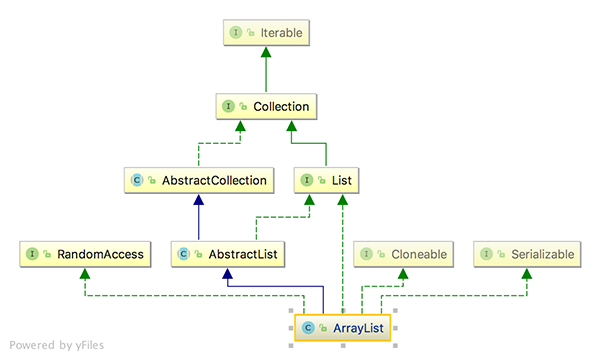ArrayList是一种最常用的集合类,底层数据结构是数组,提供动态扩展数组长度的特性,允许元素的值为null。ArrayList是一种非线程安全的集合类,若要在多线程的环境,需要注意同步问题,也可以使用Collections.synchronizedList()方法保证线程安全问题。
继承关系

构造方法
默认构造方法,创建一个空的数组对象
public ArrayList() {
super();
this.elementData = EMPTY_ELEMENTDATA;
}
private static final Object[] EMPTY_ELEMENTDATA = {};
创建指定大小的数组对象
public ArrayList(int initialCapacity) {
super();
if (initialCapacity < 0)
throw new IllegalArgumentException("Illegal Capacity: " +
initialCapacity);
this.elementData = new Object[initialCapacity];
}
根据一个集合对象创建ArrayList
public ArrayList(Collection<? extends E> c) {
elementData = c.toArray();
size = elementData.length;
// c.toArray()的返回结果可能并不是Object数组对象
if (elementData.getClass() != Object[].class)
elementData = Arrays.copyOf(elementData, size, Object[].class);
}
主要方法
add
public boolean add(E e) {
ensureCapacityInternal(size + 1);
elementData[size++] = e;
return true;
}
// 确定数组大小
private void ensureCapacityInternal(int minCapacity) {
if (elementData == EMPTY_ELEMENTDATA) {
minCapacity = Math.max(DEFAULT_CAPACITY, minCapacity);
}
ensureExplicitCapacity(minCapacity);
}
// 数组扩容
private void ensureExplicitCapacity(int minCapacity) {
// 记录ArrayList结构被修改的次数
modCount++;
if (minCapacity - elementData.length > 0)
grow(minCapacity);
}
private void grow(int minCapacity) {
int oldCapacity = elementData.length;
// 当前数组大小的1.5倍
int newCapacity = oldCapacity + (oldCapacity >> 1);
if (newCapacity - minCapacity < 0)
newCapacity = minCapacity;
if (newCapacity - MAX_ARRAY_SIZE > 0)
newCapacity = hugeCapacity(minCapacity);
// minCapacity is usually close to size, so this is a win:
elementData = Arrays.copyOf(elementData, newCapacity);
}
public void add(int index, E element) {
// 数组越界检测
rangeCheckForAdd(index);
ensureCapacityInternal(size + 1);
// 将元素插在指定的位置
System.arraycopy(elementData, index, elementData, index + 1,
size - index);
elementData[index] = element;
size++;
}
get
返回指定位置的元素
public E get(int index) {
rangeCheck(index);
return elementData(index);
}
set
将原数组中的元素返回,并将新元素插入
public E set(int index, E element) {
rangeCheck(index);
E oldValue = elementData(index);
elementData[index] = element;
return oldValue;
}
remove
// 移除指定位置元素
public E remove(int index) {
rangeCheck(index);
// 记录数组结构修改次数
modCount++;
// 原值
E oldValue = elementData(index);
int numMoved = size - index - 1;
if (numMoved > 0)
System.arraycopy(elementData, index + 1, elementData, index,
numMoved);
elementData[--size] = null; // clear to let GC do its work
return oldValue;
}
// 移除指定对象
public boolean remove(Object o) {
if (o == null) {
for (int index = 0; index < size; index++)
if (elementData[index] == null) {
fastRemove(index);
return true;
}
} else {
for (int index = 0; index < size; index++)
if (o.equals(elementData[index])) {
fastRemove(index);
return true;
}
}
return false;
}
本文由博客一文多发平台 OpenWrite 发布!